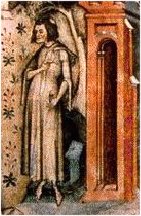Guillaume de Machaut

Whatever anyone may say about his Mass, Guillaume de Machaut is seen as the most famous, and arguably the most important composer of the Middle Ages. Even 650 years after its writing, the Messe de Nostre Dame is still relevant, and considered the finest example of Medieval polyphony. Though he is better known as a composer of music, he produced much larger volume of poetry and secular song. For the time, he was so well respected that his work was preserved in prepared manuscripts, as to avoid having such music lost. From this, most of his work has been retrieved and archived, to a much greater extent than many one would expect from the period, and many motets, lais, virelais, rondeaux, and ballades along with the mass have been re-edited, and rewritten into modern notation.
Machaut lived more like a trouvère than a cleric, travelling as widely as Poland and Lithuania to work for his patrons, writing and performing poetry and song for formal occasions. Because of this, there is generally a low volume of sacred music in the Machaut catalogue, even if he is better known for the quality of such music. However, during his lifetime he was just as well known for his poetry and secular song ; in fact, three-quarters of his work is poetry, not put to song, scattered with mathematical and arithmetic puzzles in way of structural intricacies and niggly anagrams.




